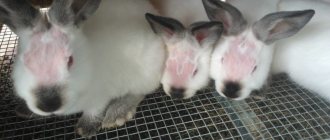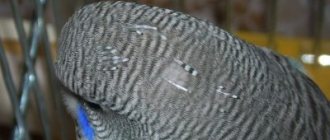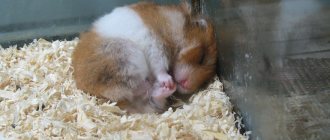Pets can also get sick, including various skin diseases. More often, hamsters experience baldness for various reasons, allergic dermatitis and, less commonly, lichen.
Ringworm in a hamster manifests itself in the form of bald areas of skin, itching and scabs from scratching.
To make an accurate diagnosis, it is important to contact a veterinary clinic, because the disease is infectious in nature and does not go away on its own.
The specialist will determine whether this disease can be dangerous for humans and will suggest how to treat the animal by selecting the appropriate medications.
Domestic rodents are susceptible to several types of fungal skin infections:
- scab;
- dermatophytosis;
- ringworm.
They all have similar symptoms and are infectious in nature, and the last two are contagious to humans.
Why does shedding occur?
All animals sooner or later begin to change their fur. Hamsters are no exception. This can occur for several reasons.
- Due to age. The bottom line is that at the age of 5 months, hamsters can change their fluffy fur to denser hair (molting is observed).
- Due to seasonal processes. Hamsters shed only in spring and autumn. This is due to the fact that weather conditions are changing.
Article on the topic: The structure of the skeleton and body of hamsters, temperature and features distinctive from mice
Usually, the molting process cannot be seen with the naked eye. If your rodent is not sick and is quite active, then there is no need to worry. This is a normal physical process that cannot be influenced. For example, small Djungarian hamsters have only three coat colors. As soon as they “survive” the moult, the number of shades doubles.
What infections are contagious to humans?
Scab, ringworm and dermatophytosis have a detrimental effect on the human body, causing almost the same symptoms as in animals. Therefore, if you are treating your pet at home, you need to protect yourself and all family members. Be sure to wear disposable gloves when performing treatment procedures. Objects that the sick animal has come into contact with must be treated; if possible, it is better to boil them.
People with weakened immune systems and prone to frequent stress are often susceptible to these infections; children most often suffer from dermatophytosis.
Diagnostics
An infection can only be diagnosed by taking tests in the form of scraping from the affected areas to determine the fungus.
Prevention
Regularly treat the room with bleach. Balance your hamster's diet by giving food mixtures containing plenty of proteins and vitamins. You often need to change the water in your hamster's drinking bowl. Maintain good hygiene. It is recommended to vaccinate twice a year .
Remember that a fungal infection is a serious disease that requires timely seeking help from a veterinarian, so as not to worsen the hamster’s condition. The early stage of any infection is completely curable without relapse. Approach the treatment of your pet with all responsibility, because with improper treatment, the disease can become chronic, and your pet will be susceptible to permanent diseases of a similar etiology. You should also not self-medicate, as ignorance can be fatal.
What I am a master at is talking incessantly about hamsters. I have three hamsters at home, and my husband has a pet rat. That’s how we live, the six of us eat, the six of us sleep :)
Source
The reason is poor nutrition
Why does a hamster lose hair? Most likely, the reason is the pet’s improper diet. You may notice not only hair loss on the back, but also peeling on the animal’s skin. There is such a problem, but it is quite simple to solve if you approach the issue correctly.
If your hamster's hair falls out due to poor nutrition, it needs to be balanced. It is believed that the ideal diet for treating baldness is a large amount of greens and medical supplements in food. If you notice hair loss in hamsters in time and begin treatment immediately, the process will only take a few weeks.
In just a few weeks, you will notice that the hamsters have begun to grow new hair. If the cause of the disease lies in the poisoning of the animal, then you should stop giving your pet fresh fruits or fresh vegetables. They should be replaced with dry food (high quality) and plenty of clean drinking water.
Diagnosis of rodent diseases
If you yourself were able to determine why your hamster’s hair is falling out and found the source of the unpleasant causes, immediately remove the irritant and observe the animal’s further reaction. The situation when a pet has suffered baldness due to intolerance to the bedding or material renewal in the cage can be quickly corrected without serious consequences.
If your hamster has eaten previously unfamiliar foods or low-quality food, return him to his previous diet and make sure that the food is fresh and of decent quality. By eliminating allergens, the hamster will soon recover. When the reasons lie deep and only a specialist can determine them, do not waste time and seek veterinary help.
Possible diagnoses and treatments:
- Poor or unhealthy diet. If the cause of the disease lies in the rodent’s diet, the doctor will recommend changing the diet, and in some cases will prescribe a separate dietary menu for the rodent. This could be a diet with lots of greens, with a variety of nutritional supplements that the animals can eat. Correct diagnosis and timely treatment will allow the animal to become healthy within a month. The first signs of a successful cure appear already in the first week: the development of the disease stops, and the bald parts of the skin begin to grow with new fuzz.
- Fungi or viruses. They are characterized by symptoms when the animal's skin peels off, accompanied by hair loss. When an infection of this nature is detected, rodents are prescribed special ointments, which can be easily purchased both in the clinic itself and in veterinary stores. The ointment is regularly applied to the affected areas of the skin until the signs of baldness disappear. In order to consolidate the result and prevent it, you can repeat the application of the ointment several times even after the rodent has recovered.
- Allergic reactions. It is quite difficult to detect the cause of the allergy, so the doctor will ask you to remember the next few days before the onset of the disease. This could include possible changes in the cage (new litter or toys), as well as the rodent’s diet in detail. By the way, at the first symptoms of baldness, it is important to ask yourself such questions. If the animal is offered a different filler, replace it with the same one and thoroughly wash the cage. Preferably with a disinfectant to eliminate residual reactions. Do not use chlorine because it is harmful to the animal. Pay detailed attention to your hamster's nutrition. To eliminate food poisoning, you can temporarily switch your animal to dry food.
- Stressful situations. If a hamster loses its fur, but there are no other reasons why the animal began to go bald, stress may be to blame. The rodent will need absolute rest. Place the cage in a quiet place, try to rid the animal of sharp and loud sounds. Give him a good rest, including from your own attention. The animal needs time to get back to normal.
- Age-related changes. Unfortunately, rodents age very early and already at the age of 2 years show the first signs of impending death. Some individuals begin to lose fur at a slightly earlier age. In this case, nothing can help the animal. Try to surround him with care and pamper him with delicious treats, making his days carefree and cozy.
Viral diseases or fungus
We correctly determine the cause
You can often hear the question of why a hamster's hair falls out. Experienced experts say that this may be a consequence of a fungus or virus. The symptoms of such diseases are that the skin begins to peel off or hair loss occurs.
In order to get rid of such signs, you should buy a special ointment. It is not difficult to buy it at a specialized veterinary pharmacy or from a doctor. It should be smeared on sore areas of the skin. To prevent the recurrence of the disease, it is recommended to use the ointment even after the unpleasant symptoms have disappeared.
Article on the topic: Why does a hamster sleep constantly: normal or abnormal?
Ringworm
Ringworm is the general name for a group of diseases that cause itching, redness of the skin and hair loss. Sores appear on the animal's body and the skin peels off. The causative agents of this disease are bacteria and viruses. There are two types of lichen: ringworm and pink lichen. The most common ringworm found in hamsters is trichophytosis.
This infectious disease is very dangerous as it is transmitted to humans. The incubation period is long and can last a month. Young hamsters get sick more often than adults, and the disease is difficult to tolerate. They have not yet developed immunity against various infections. At home, trichophytosis occurs due to poor care of the rodent and dirt in the cage. A person himself can bring the virus into an apartment from the street. There are several symptoms of ringworm:
- Wounds and scales form and become crusty.
- Areas of skin on the head, neck and paws become bald. The hairs break at the base, and in the photo the dzhungarik looks trimmed.
- Scabs appear and the hamster is constantly itching.
- Pus oozes from the wounds.
- The animal becomes aggressive and loses its appetite.
Allergic reactions and stress
Sometimes a hamster's fur will fall out because it has an allergic reaction. The problem is that identifying it is much more difficult than it might seem at first glance. You need to pay attention to what new has appeared in the animal’s cage. Perhaps it's all about the new diet or arrangement of the cell. In such cases, it is necessary to immediately return everything back so as not to provoke the animal into suffering.
You should also wash your pet's cage regularly, but without using chlorine, as it is dangerous for rodents. In order to correct a nutritional error, you should switch your hamster to dry food.
If the problem was stress, then you need to analyze what new things you did for your pet. Perhaps he did not like the new habitat or the constant noise. At such moments, you should put the cage in its old place and protect the animal from strong noises. You will soon notice that his condition has returned to normal and his fur has stopped falling out.
What to do if your hamster is constantly itching?
Cute, charming fluffy balls - hamsters are quickly winning our hearts. And the one who got such a pet is in vain to think that there will be little trouble with it, because it does not need to be walked or trained. Hamsters also need proper care, because various parasites prey on these animals. Therefore, in order to understand why a hamster itches and what to do in this case, we suggest studying all the possible causes of this unpleasant condition.
Reasons for constant scratching
How can I help my fluffy?
Video “Cleaning a hamster cage”
Comments and Reviews
Molting in hamsters
Molting is the process of shedding old fur and the appearance of new hair. There are several types of shedding:
- Seasonal - depends on the changing seasons. Fur falls out most intensively in the autumn and spring periods.
- Age-related - happens unnoticed by the owner. At the age of 4 months, young rodents replace their soft and delicate fur with a harder one.
- Associated with disorders of the life process. Baldness can be caused by various diseases.
Article on the topic: Hamster with stuffed cheeks, cheeky hamster, cheek pouches
Do hamsters shed without illness? Yes, this is a natural process. But the Syrian hamster changes its fur without bald spots. And the Djungarian prepares for winter by changing its dark fur to lighter one.
If an animal loses its fur, but is active and has a good appetite, there is no cause for concern. Most likely, he has a seasonal change in his coat.
Most often, molting in hamsters caused by disease begins with baldness of the head, then the abdomen and the area around the eyes. If your hamster is going bald on its back, the rest of its body needs to be examined. This will help determine the presence of diseases in the rodent. If an animal not only loses its hair, but also has peeling skin, or aggression is observed, it is necessary to conduct a laboratory analysis of the body. With the help of surgical intervention by specialists, hair loss can be prevented.
Fungal diseases of hamsters: symptoms and treatment
Fungal diseases of hamsters: symptoms and treatment. Infections caused by spores of various types of fungal flora. Diagnosed only by veterinary specialists. Ratologists at the Vetmaster veterinary center will help diagnose fungal infections and prescribe correct and effective treatment for your pet, which consists of local and systemic antifungal therapy and immunostimulation of the animal’s body. Of the existing fungal infections, the most common are:
Actinomycosis. It is caused by the so-called radiant fungus of the genus Actinomyces, which enters the hamster’s body with infected cereal plants. Symptoms: damage to the bones and muscles of the jaws, gums and teeth, the junction of the incisors is displaced and they are worn incorrectly, discomfort occurs while eating.
Dermatophytosis. Caused by fungi of the genus Trichophyton and Microsporum. Dangerous for humans. Symptoms: gray, dry, flaky patches of baldness on the rodent’s body, itching, scratching.
Scab. Caused by a fungus of the genus Achorion. Symptoms: loose, abundant peeling in the ears and eyes, the presence of gray small blisters, then crusts and sores, itching, scratching.
Causes of pathological hair loss
- Poor nutrition. This is one of the most common reasons why a hamster goes bald. To eliminate the problem, it is necessary to balance the rodent's diet. The veterinarian will help you create a dietary menu, which must include greens. Additionally, he will recommend special supplements.
A new product in the usual diet can cause an allergy in a hamster. It may also be accompanied by shedding. It is necessary to exclude the allergic component from the hamster’s diet and transfer it to a diet menu. If you follow the correct feeding regimen, improvements will occur within a month. Fuzz will appear on bald areas, and your pet will feel much better.
- Stress. Sometimes a Syrian hamster goes bald when it is not in a comfortable environment. The stress suffered often causes disturbances in the animal’s behavior and contributes to the appearance of molting. A stressful situation for a rodent can be moving to a new place, the appearance of a cagemate, new food, or even a loud TV. Sleep disturbances and loss of appetite are also the result of stress. You need to give your pet time to adapt and not show increased attention to him. Create comfortable conditions for your pet and his condition will improve.
- Reproductive functions. Feeding offspring can cause a hamster to go bald. In females, pregnancy may be accompanied by hair loss, and feeding may result in baldness of the abdominal area. Ovarian tumors are quite common in hamsters, as is inflammation of the uterus.
- Gastrointestinal tract disorder. If your hamster's hair is falling out, the cause may be due to intoxication with harmful substances. Poisoning from poor-quality food means that the rodent's fur will not be as soft and silky as usual. This is due to the fact that nutrients and vitamins do not accumulate in the body. Pesticides in vegetables and fruits can cause diarrhea in the animal, which is also accompanied by shedding.
- Dental problems. Constantly growing teeth can cause your rodent to shed. When new teeth do not grind down and incisors become brittle, increased saliva production is observed. Because of this, the fur begins to get wet and fall out over time. To grind down teeth, you can purchase a mineral stone or put branches and hard sticks in the cage.
- Old age. If a dwarf's fur falls out, this may be due to the animal's old age. In rodents, signs of aging appear very early, at the age of 2 years, and in some individuals even earlier. A bald hamster is not a pleasant sight, but you can’t do anything to help the old man. During this period, it is necessary to surround your pet with care and feed it the most delicious and healthy food.
Article on the topic: Hamster - description of the animal for children and adults (features, character, photo)
Treatment
Certain types of fungus are treated exclusively with antifungal drugs, which should be prescribed by a specialist . Having determined the type of fungus and the degree of infection, the required dosage of the drug and course of treatment are prescribed.
| Triderm | Complex antifungal drug that is applied externally | The course of treatment is 10-14 days. During this period, you need to apply a thin layer of ointment to the affected areas of the skin 2 times a day. |
| Fluconazole | An antifungal drug that suppresses the synthesis of fungal spores, which should be used once a day | Course of treatment 2–4 weeks |
| Griseofulvin | Antibiotic prevents fungal cell division | The course of taking the drug is prescribed by a veterinarian |
| Ketoconazole | A broad-spectrum drug that allows you to stop the synthesis of cell membrane substances, destroying the fungal membrane | Treatment course 10 days |
Prevention of baldness
Preventing baldness will not only help prevent hair loss, but also improve your hamster's mood. There are several preventative measures:
- Feed your pet only high-quality products.
- Add greens and vitamins to dry food in moderation.
- Clean the cage and toys regularly.
- Make sure the bedding is clean and dry, otherwise the urine will irritate the coat and skin.
- Always provide clean drinking water in the cage.
- Make sure the animal avoids stressful situations.
To avoid hair loss, it is important to properly care for the dwarf. Keeping an animal in uncomfortable and inappropriate conditions causes stress, apathy, and loss of appetite, which is accompanied by molting. If you change the bedding in a timely manner and feed the animal with high-quality and healthy food, the hamster will be healthy.
Hamsters need proper care and attention. A healthy rodent should have soft and shiny fur, a good appetite and a playful mood. Shower your pet with love and he will love you back.
Reasons why a hamster loses hair
One of the common diseases of rodents is the appearance of bald spots on the fur. The coat of most animals is an indicator of health. Hamsters are no exception.
Sometimes the owner of a rodent notices that the pet loses its fur when kept indoors. Taking into account the fact that many skin diseases that cause baldness in animals are transmitted to people , the owner’s anxiety is quite justified.
But sometimes there are situations when hair loss is completely normal. Let's look at cases when hair loss is normal and when there is cause for concern.
Contact your veterinarian
In order for your pet to recover, there are many specialized medications that can fight the disease of baldness. But if you want to quickly and effectively treat your pet, consulting a veterinarian is still necessary.
Only a qualified specialist will give an accurate assessment of hamster baldness, make the correct diagnosis and prescribe the necessary treatment.
The veterinarian determines why a hamster is going bald based on preliminary tests of the rodent. Under a specialized lamp, a thorough examination of the animal’s skin is carried out and a skin scraping is taken.
Treatment is prescribed after receiving test results and a comprehensive review of symptoms. The main thing is to consult a doctor in time, diagnose the disease, identify its cause and begin treatment, and your animal will regain its excellent fur!
Causes of loss
A healthy and active hamster loses its hair
If the animal behaves as usual, it moves actively and eats well, but the owner notices that its fur is simply “falling off,” then perhaps it’s all about molting. Seasonal coat changes are typical for animals in the wild.
Article on the topic: Is it possible to keep a dwarf and a Syrian hamster alone; will two hamsters get along together?
In indoor conditions, this process is more extended, although very often it goes almost unnoticed. In this case, everything is individual. You can also distinguish seasonal shedding from pathological baldness by the color of your coat.
During the period of molting on the animal, the hairs differ in color. Bald spots as a result of shedding are most often noticeable on the stomach and the inside of the legs. This is much less noticeable on the back.
Why do hamsters go bald at the age of 2-3 years?
A pet may lose its fur from old age. If a pet has celebrated its second or third birthday and its fur has become sparse and coarse, and skin diseases are excluded, then there is only one reason - old age.
In this case, the aging process cannot be stopped. Hair loss does not bother the pet and it is enough to organize good care so that the animal lives out the allotted time in comfort.
Hair falls out and skin peels
When hair loss is accompanied by peeling skin, the owner has real reasons not only to worry, but also to contact a veterinarian.
Many people put off visiting the clinic, blaming everything on allergies. Losing time can negatively affect the health of the rodent. After all, in addition to allergies, the cause of baldness is damage to the skin by microscopic fungi that cause lichen. Most often we are talking about trichophytosis or microsporia.
Areas without hair are round in shape and broken hairs are visible. They appear near the ears, on the face and sides. The skin is smooth at first, but as the disease progresses it becomes inflamed, and suppuration and scabs may appear.
Very often, the causative agents of lichen get onto the animal from clothing or human hands.
In advanced forms, the animal loses its appetite and behaves aggressively. The diagnosis is made by a doctor, who also selects adequate treatment.
Hair falling out on the hamster's back
Only a doctor can prescribe treatment. Small seals without hair appear on the rodent's face. Gradually they merge into more extensive scabs and affect the back of the animal through the neck and withers.
Article on the topic: How long do hamsters live at home, average life expectancy
The cause of the appearance of bald spots on the back of the animal is microscopic mites - demodexes. With this pathogen, itching is rare.
An accurate diagnosis is made by examining skin scrapings under a microscope. Treatment is prescribed by a doctor after identifying the pathogen.
Skin parasites in hamsters as a cause of baldness
Parasites cause itching. The following parasites can settle on the skin under the fur of a rodent:
The main symptom of the disease is itching. The animal is itching desperately. In areas of scratching, not only hair falls out, but also inflammatory processes begin.
Once the diagnosis is made, the veterinarian will prescribe contact insecticides. It may be necessary to treat the animal for worms before using them.
When treating with drugs for internal and external use, you need to take into account the size of your pet.
Other reasons
If hair falls out in the tail area, lower abdomen, or on the inside of the hind legs, then the reason is frequent urination. It is caused by diseases of the genitourinary system. An upset bowel movement can cause hair loss in the anal area. Only by eliminating the underlying disease can hair loss be stopped.
A stressful situation, feeding low-quality food, intoxication can also cause hair loss.
Why does the dzhungarik go bald?
Follow a proper diet. One of the reasons for the loss of hair in dzhungarika is errors in nutrition. It is advisable to reduce foods high in carbohydrates, remove whole grains and exotic fruits, and add fresh herbs, crushed grain mixtures and oak or hazel twigs to the diet.
The diet must contain protein foods. Even a piece of boiled chicken will do. Protein should be about 15% of the daily diet.
Why does the Syrian hamster go bald?
If areas without fur appear on the head or face of a pet, then mechanical abrasions on the bars of the cage are to blame. To avoid this, try to replace it with a special terrarium, where the lower part is solid and made in the form of a tray.
Article on the topic: Why does a hamster squeak, cry or scream (yell): reasons for the sounds of Djungarian and Syrian rodents in their sleep
Watch your pet. If a Syrian or other hamster has recently appeared in the house, stress and the transition to a new diet are to blame. After 10 - 12 days the animal gets used to it, and the hair loss stops.
Scab
The causative agent of this disease is the fungus Achorion Schoenleini. Depending on the stage of development, it can look different, and has a high degree of stability in the external environment.
The incubation period of the disease ranges from several days to two weeks. As a rule, hamsters get scab in the warm season - spring and summer. The disease can be transmitted through contact with unhealthy animals and through insect bites, contaminated feed, cages, equipment, or through an owner who does not maintain hygiene.
Scab appears as a scaly white coating at the base of the ears, on the tip of the nose, on the pet’s eyebrows, and less commonly on other parts of the body. The lesions are round in shape and can reach a diameter of up to a centimeter. The affected areas become covered with gray blisters, which enlarge and then form crusts with several hairs in the center.
Scab
Treatment
Scab has characteristic external signs by which it can be distinguished from other diseases, but an accurate diagnosis will require a microscopic examination.
Sick pets must be isolated due to the highly contagious nature of the disease. Measures are required to improve sanitary and hygienic measures and ensure good ventilation of the premises. After isolating sick animals, cages, equipment, floors and adjacent surfaces are treated with disinfectants.
The affected areas of sick jungarians are cleaned of scabs and scales, previously softened with neutral fats or oils. The affected areas are treated daily until recovery with iodine tincture in equal proportions with alcohol solutions of creolin, Lysol, salicylic or picric acid, and glycerin.
What to do
If changing the bedding, good care and a nutritious diet have not stopped the hamster’s hair loss, then a visit to the veterinary clinic is essential. Unfortunately, not all doctors undertake to treat rodents.
Try to find a blade that has a specialist - a ratologist.
If there is no such hospital, the Internet will come to the rescue. Post good photographs of your pet on specialized veterinary websites, describe the problem in detail and get qualified advice.
Prevention
The disease is easier to prevent than to treat. With regard to skin diseases in rodents, the following measures must first be observed:
- do not approach the hamster in street clothes and shoes;
- handle your pet with washed hands;
- follow quarantine rules after acquiring a new animal;
- maintain the animal’s home in good sanitary condition;
- protect your pet from stressful situations.
If trouble happens and the pet dies from skin problems, then before purchasing a new hamster you need to do a general cleaning of the room and thoroughly disinfect all equipment and the cage.
The health of pets depends on the owner. Inattention and negligence can destroy even such an unpretentious creature as a hamster.











